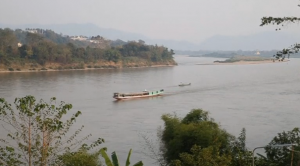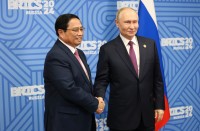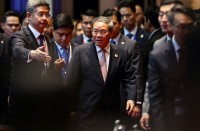
(Reuters) — The Lao People’s Army patrol boat is custom-made in China with night-vision capability and two of the most powerful engines on this remote stretch of the Mekong River.
However the lack of resources, such as gasoline, means the boat often stays docked and unused.
Even occasional patrols by boats like these, supplied by China to the Lao army and Myanmar police, have successfully subdued the pirates who once robbed the Mekong’s cargo ships with impunity.
But the boats also underscore the limits of China’s hard power in mainland Southeast Asia, even as the Asian giant accelerates its militarisation of disputed islands in the South China Sea.
Thanks to the existing joint marine patrols by Myanmar, Laos, Thailand, and China after a 2011 Mekong River massacre, attacks on cargo ships have tapered off. But the United Nations Office on Drugs and Crime (UNODC) says drug production and trafficking in the so-called Golden Triangle is booming.
UNODC estimates Southeast Asia’s trade in heroin and meth is worth $31 billion a year.
The UNODC recently gathered senior anti-narcotics police and officials from five countries, among them China’s top international anti-drugs csar, General Wei Xiaojun, for a four day trip down the Mekong river.
Setting sail from the Chinese port of Jinghong and cutting through the heart of the Golden Triangle, the voyage was both a demonstration of China’s soft power and a bid to muster the regional collaboration needed to tame the lawless region.
“The main threat along the river is in this region, mostly derived from illegal drug business. And all other types of organized crime are rooted in the drug business, like human trafficking, money laundering and the illegal wildlife trade,” said General Wei Xiaojun, who is Deputy Secretary General of China’s National Narcotics Control Commission
China is a favourite destination for Myanmar’s drugs, which flow through Asia in unprecedented quantities.
Over 250 million meth pills, better known by their Thai name “ya ba” or “crazy medicine,” were seized in East and Southeast Asia in 2013, an eight-fold increase since 2008.
Seizures of ice – a potent, crystalline form of meth dubbed “the poor man’s cocaine” – doubled during the same period.
In 2015, China seized a record 36.5 tons of meth, most of it from Myanmar, said the UNODC. Myanmar is the world’s second largest producer of opium, most of which ends up in China as heroin.
Myanmar also has a drug problem. Experts warn of an explosion in meth use among its 53 million people, with police last year making record-breaking busts of both ya ba and ice.
This could severely test the new government of President Htin Kyaw, whose National League for Democracy party has yet to formulate drug policies, say experts.
Many factors combine to help the Golden Triangle’s drug industry prosper.
The terrain is rugged and hostile, with rebel armies holding sway in some areas. The Myanmar-Laos border, which the Mekong delineates, is mostly unguarded. Smugglers slip across it like ghosts.
Some areas remain intelligence black holes. For example, Hsop Lwe is Myanmar’s busiest port on the Mekong, but its government has no control over it.
The port belongs to Special Region 4, a semi-autonomous enclave in Myanmar famous for gambling, prostitution and the production and trafficking of narcotics.
Adjoining it from the north is Special Region 2, an even bigger narco-fiefdom. Both are controlled by heavily armed rebels.
The Special Regions were “off the political grid,” said Jeremy Douglas, the UNODC’s Asia-Pacific chief, although he hoped Myanmar’s new government would engage with and secure better access to them.
“The other is the special regions which we cut through which are just adjacent to China and Myanmar and Lao when they come together there, special region 4, that port that we went by was incredibly active and it’s an ungoverned autonomous region off the political grid if you will. So to see how active that port was and the amount of trade and stuff going in and out was pretty interesting,” Douglas told Reuters.
Regional law-enforcement agencies are often underfunded and ill-trained, and the intelligence they gather isn’t effectively shared with counterparts in neighbouring countries.
Myanmar and Laos are also home to lawless enclaves, outside the control of any government, where drugs and money laundering flourish.
In October 2011, a gang led by a Mekong pirate called Naw Kham murdered 13 Chinese sailors. He was hunted down in Laos, then taken back to China to be tried and executed.
Afterwards, Chinese gunboats began patroling further downriver, extending China’s security reach far beyond its borders.
This includes a riverside facility in Mouang Mom in Laos, run and guarded by a 25-strong unit of Chinese People’s Armed Police.
Today, China conducts monthly joint patrols with its Lao and Myanmar counterparts, who – gasoline permitting – do additional patrols by themselves.
“Obviously, there aren’t that many patrols and we would advocate for increasing the number, the frequency and effectiveness of those patrols. I think it’s fair to say that there’s some impacts. Have they had a lot? Clearly not a lot. I mean the supply is still high and potentially, we have indication that it’s increasing,” said UNODC’s Douglas.
Landlocked and impoverished Laos shares a border with all the Mekong countries, making it an important smuggling hub for both narcotics and the chemicals that make them.







